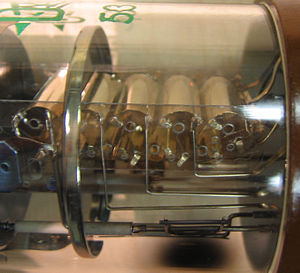Dynode

A dynode is one of a series of electrodes within a photomultiplier tube. Each dynode is at a more positive electrical potential than its predecessor. Secondary emission occurs at the surface of each dynode. Such an arrangement is able to amplify the tiny current emitted by the photocathode, typically by a factor of one million.
Operation
The electrons emitted from the cathode are accelerated toward the first dynode, which is maintained 90 to 100 V positive with respect to the cathode. Each accelerated photoelectron that strikes the dynode surface produces several electrons, that are then accelerated to the second dynode, which is held 90 to 100V more positive than dynode 1. For conventional dynode materials, such as BeO and MgO, a multiplication factor of 10 can normally be achieved by each dynode stage.[1] By the time this process has been repeated at each of the dynodes, 105 to 107 electrons have been produced for each incident photon, dependent on the number of dynodes.
Naming
The dynode is so named because it acts as a middle point between the (photo)cathode and the anode.
References
- ^ Glenn F Knoll - Radiation Detection and Measurement 3rd ed, 1999, P270, ISBN 0-471-07338-5.
